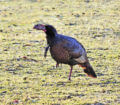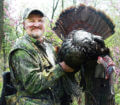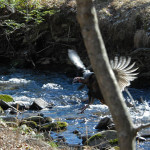Editor’s Note: Avid turkey hunter Tracy Groves of Eldersburg, Maryland, enjoys all types of hunting, including bear and deer, but says hunting turkeys is his first love.
 During the 42 days of spring turkey season, I usually turkey hunt and guide 35 to 38 days of the season. One of the things I’ve noticed is that many hunters overlook the sounds of the other critters that tell a turkey hunter about a turkey. For example, the gray squirrel gives us insight into what’s happening around us in the turkey woods. Many hunters don’t pay attention to the gray squirrel. But when a squirrel starts barking from a tree, and you’re totally camouflaged and know he hasn’t seen you move, then you must realize he’s trying to tell you something. Perhaps a predator is approaching your location like a bobcat, a coyote, a fox or a feral dog. There may be a deer coming, or that squirrel may have spotted another hunter walking in the woods. As the predator, the deer or the hunter approaches, the first squirrel will alarm another squirrel, and it will start barking. Many times you can tell where predators, other hunters and/or deer are located in the woods by simply listening to the squirrels.
During the 42 days of spring turkey season, I usually turkey hunt and guide 35 to 38 days of the season. One of the things I’ve noticed is that many hunters overlook the sounds of the other critters that tell a turkey hunter about a turkey. For example, the gray squirrel gives us insight into what’s happening around us in the turkey woods. Many hunters don’t pay attention to the gray squirrel. But when a squirrel starts barking from a tree, and you’re totally camouflaged and know he hasn’t seen you move, then you must realize he’s trying to tell you something. Perhaps a predator is approaching your location like a bobcat, a coyote, a fox or a feral dog. There may be a deer coming, or that squirrel may have spotted another hunter walking in the woods. As the predator, the deer or the hunter approaches, the first squirrel will alarm another squirrel, and it will start barking. Many times you can tell where predators, other hunters and/or deer are located in the woods by simply listening to the squirrels.
 Other critters I pay close attention to are the pileated woodpeckers and hawks. When a pileated woodpecker squawks in the woods, he can make a turkey shock gobble. When a hawk screams, he can make a tom turkey talk. Of course everyone knows to listen after a crow calls or an owl hoots to see if a gobbler gives away his location. When I’m moving from place to place in the turkey woods, if I hear a pileated woodpecker scream, I’ll stop and listen. If I hear a hawk give out that sharp high-pitched scream that it makes, I’ll stop and listen. A true woodsman will be listening to all the voices in the woods and all the animals in the woods to pinpoint a turkey’s location. If I’m guiding a hunter, I’m listening to what that hunter is saying when we’re sitting down to listen for the turkey to gobble, but I’m also listening to the sounds of the critters in the woods. Many times after you call, and the woods are silent, you may hear a very-low, almost-inaudible sound of a turkey drumming that sounds somewhat like an 18-wheeler down-shifting as the truck comes off a mountain.
Other critters I pay close attention to are the pileated woodpeckers and hawks. When a pileated woodpecker squawks in the woods, he can make a turkey shock gobble. When a hawk screams, he can make a tom turkey talk. Of course everyone knows to listen after a crow calls or an owl hoots to see if a gobbler gives away his location. When I’m moving from place to place in the turkey woods, if I hear a pileated woodpecker scream, I’ll stop and listen. If I hear a hawk give out that sharp high-pitched scream that it makes, I’ll stop and listen. A true woodsman will be listening to all the voices in the woods and all the animals in the woods to pinpoint a turkey’s location. If I’m guiding a hunter, I’m listening to what that hunter is saying when we’re sitting down to listen for the turkey to gobble, but I’m also listening to the sounds of the critters in the woods. Many times after you call, and the woods are silent, you may hear a very-low, almost-inaudible sound of a turkey drumming that sounds somewhat like an 18-wheeler down-shifting as the truck comes off a mountain.
The difference between a turkey hunter and a woodsman is that a turkey hunter is hunting a turkey, and he’s focused only on hearing a gobbler. A woodsman is listening to all the sounds in the woods and all the critters in the woods. He’s more aware of what may be coming to him or happening around him than a person who is only looking for a turkey.
 To learn more about turkey hunting, check out John E. Phillips’ print, Audible and Kindle turkey books at https://johninthewild.com/books/#turkey. For a free copy of John E. Phillips’ “The Turkey Gobbler Getter Manual,” go to https://johninthewild.com/free-books/.
To learn more about turkey hunting, check out John E. Phillips’ print, Audible and Kindle turkey books at https://johninthewild.com/books/#turkey. For a free copy of John E. Phillips’ “The Turkey Gobbler Getter Manual,” go to https://johninthewild.com/free-books/.
















